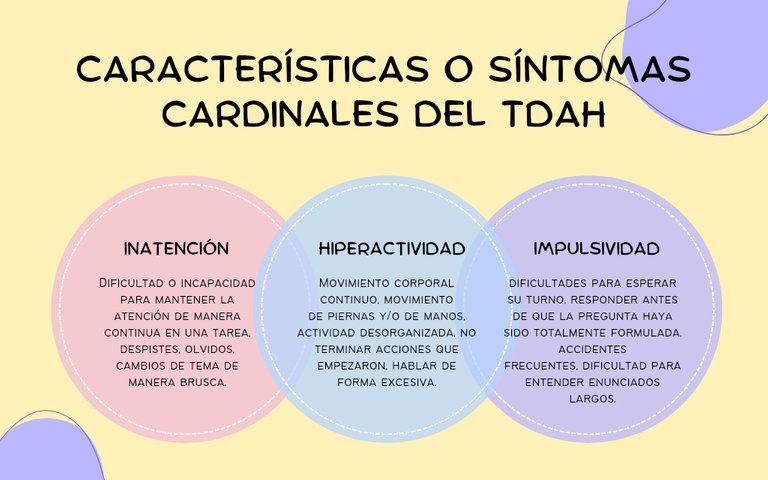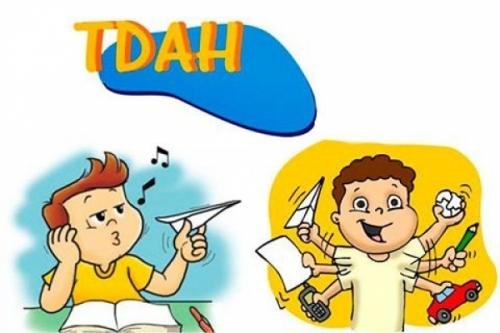¡Hola queridos usuarios de Hive ✨💕!
Hi dear Hive users ✨💕!
Quizá éste sea, después del Trastorno del Espectro Autista, uno de los trastornos del neurodesarrollo mas conocido por todos nosotros, que resulta ser el motivo de consulta mas frecuente en la psicoterapia infantil y además el diagnóstico popularmente dado por excelencia a los niños y niña con comportamientos intranquilos, el día de hoy les estaré compartiendo a groso modo acerca del Trastorno por Déficit de Atención e Hiperactividad (TDAH).
Perhaps this is, after Autism Spectrum Disorder, one of the most well-known neurodevelopmental disorders for all of us, which happens to be the most frequent reason for consultation in child psychotherapy and also the diagnosis popularly given par excellence to children with restless behaviours, today I will be sharing with you roughly about Attention Deficit Hyperactivity Disorder (ADHD).


👧🏻 ¿Qué es? || What is it? 🧒🏻
El trastorno por déficit de atención e hiperactividad se cataloga como un trastorno del neurodesarrollo que se caracteriza principalmente por la inatención, hiperactividad e impulsividad. Los síntomas suelen presentarse en edades tempranas y en la actualidad se estima que los mismos se manifiesten antes de los 12 años. Además de las características principales previamente mencionadas, también se han encontrado diversas dificultades en las funciones ejecutivas, las cuales se ven reflejadas en el inconveniente a la hora de atender a ciertos estímulos, planificar y organizar una acción, reflexionar las posibles consecuencias para ciertas acciones, entre otras.
Attention deficit hyperactivity disorder is categorised as a neurodevelopmental disorder characterised mainly by inattention, hyperactivity and impulsivity. Symptoms usually present at an early age and are currently estimated to manifest before the age of 12. In addition to the main characteristics previously mentioned, various difficulties have also been found in the executive functions, which are reflected in the difficulty in attending to certain stimuli, planning and organising an action, reflecting on the possible consequences of certain actions, among others.

El TDAH representa aproximadamente el 50% de las consultas en psicología y psiquiatría infantil y su prevalencia va de un 2 a 12% de la población pediátrica. Su causa resulta multifactorial, aunque hay autores que manifiestan que aun resultan desconocidas, sin embargo se infiere que existe una influencia genética y ambiental, en tal sentido los factores ambientales funcionan como desencadenantes o moduladores de la carga genética. El componente hereditario del TDAH posee una gran relevancia, de tal forma que un niño cuyo padre posea TDAH (diagnosticado o no), tiene un riesgo de 2 a 8 veces más que la población general, de también presentar el trastorno.
ADHD represents approximately 50% of consultations in child psychology and psychiatry and its prevalence ranges from 2 to 12% of the paediatric population. Its cause is multifactorial, although there are authors who state that it is still unknown, however it is inferred that there is a genetic and environmental influence, in this sense environmental factors act as triggers or modulators of the genetic load. The hereditary component of ADHD is highly relevant, in such a way that a child whose father has ADHD (diagnosed or not), has a risk of 2 to 8 times more than the general population, of also presenting the disorder.

👧🏻 ¿Cuáles son sus tipos? || What are their types? 🧒🏻
El TDAH puede presentarse bajo 3 modalidades:
Predominantemente hiperactivo-impulsivo: Son niños que a menudo muestran inquietud con las manos o pies, suelen abandonar con frecuencia su sitio en el salón de clase o en otras circunstancias donde se espera que permanezcan sentados, por ejemplo a la hora de comer, suelen hablar de forma excesiva e incluso acabar frases o responder preguntas antes de que terminen de formularlas, además se les es difícil esperar su turno en ciertas situaciones y sienten dificultad para jugar o realizar de manera tranquila actividades de distracción.
Predominantemente inatento: Suelen ser niños que aunque se encuentren tranquilos, no quiere decir que estén prestando atención, suelen cometer errores por descuido en sus tareas escolares, mayormente por la falta de atención a los detalles minuciosos, dan la impresión de no escuchar cuando se les habla directamente y poseen dificultades para cumplir instrucciones y organizar tareas o actividades. Pierden cosas necesarias para la realización de actividades y llegan a evitar o mostrar aversión hacia las tareas o actividades que requieren esfuerzo mental o sostenido, además se distraen con facilidad ante la presencia de estímulos extraños. Puede existir una prevalencia mínima de indicadores de hiperactividad-impulsividad, es decir menos de 6 síntomas.
Combinación de hiperactividad-impulsividad e inatención: Esta suele ser la forma más común de TDAH y se caracteriza por el predominio de ambas formas, tanto hiperactividad-impulsividad como de inatención, en tal sentido deben existir 6 o más síntomas de ambas modalidades.
ADHD can present in 3 forms:
Predominantly hyperactive-impulsive: These are children who often show restlessness with their hands or feet, frequently leave their seats in the classroom or in other circumstances where they are expected to remain seated, for example at mealtimes, they tend to talk excessively and even finish sentences or answer questions before they have finished asking them, they also find it difficult to wait their turn in certain situations and find it difficult to play or carry out distracting activities in a calm manner.
Predominantly inattentive: These are usually children who, although they are calm, do not pay attention, often make careless mistakes in their schoolwork, mostly due to lack of attention to minute details, give the impression of not listening when spoken to directly, and have difficulty following instructions and organising tasks or activities. They lose things needed for activities and may avoid or show aversion to tasks or activities that require mental or sustained effort, and are easily distracted by extraneous stimuli. There may be a minimal prevalence of indicators of hyperactivity-impulsivity, i.e. less than 6 symptoms.
Combination of hyperactivity-impulsivity and inattention: This is usually the most common form of ADHD and is characterised by a predominance of both forms, both hyperactivity-impulsivity and inattention, in such a sense there must be 6 or more symptoms of both modalities.

Es importante destacar que para el diagnóstico de cualquiera de las tres modalidades, los síntomas deben persistir por un tiempo mínimo de 6 meses, al grado de ocasionar inadaptación e incongruencia con el nivel de desarrollo, además deben presentarse en al menos 2 contextos, por ejemplo en la escuela y en el hogar, y manifestarse antes de los 12 años.
It is important to note that for the diagnosis of any of the three modalities, the symptoms must persist for at least 6 months, to the extent of causing maladjustment and incongruence with developmental level, and they must occur in at least 2 contexts, e.g. at school and at home, and manifest themselves before the age of 12 years.
👧🏻 Tratamiento y Diagnóstico Diferencial || What are their types? 🧒🏻
Es importante que todo niño y/o adolescente con TDAH cuente con un tratamiento integral individualizado que se ajuste a la cronicidad del caso y al impacto de la condición, la mayoría de las veces el tratamiento involucra medidas psicofarmacológicas y terapia psicológica, además se deben considerar las inquietudes y preferencias de la familia, la psicoeducación juega un papel fundamental en la adherencia al tratamiento, resulta importante informar a la familia acerca de la condición del caso y los tratamientos disponibles, siempre teniendo presente que el objetivo central del tratamiento es el mejoramiento de las manifestaciones centrales y la disminución de las dificultades conductuales.
En otro orden de ideas, debido a la complejidad del diagnóstico del Trastorno por Déficit de Atención e Hiperactividad, sobre todo en edades muy tempranas, se pueden llegar a hacer diagnósticos diferenciales que permitan detallar el caso que se presenta, en tal sentido se suele comparar con una serie de trastornos entre los cuales encontramos, trastorno bipolar, trastornos de ansiedad, trastornos depresivos, trastorno del espectro autista, trastorno negativista desafiante, trastornos explosivo intermitente, trastorno de desregulación disruptiva del estado el ánimo, entre otros.
It is important that every child and/or adolescent with ADHD has a comprehensive individualised treatment that is adjusted to the chronicity of the case and the impact of the condition, most of the time the treatment involves psychopharmacological measures and psychological therapy, and the concerns and preferences of the family should also be considered, psychoeducation plays a fundamental role in adherence to treatment, it is important to inform the family about the condition of the case and the available treatments, always bearing in mind that the central objective of treatment is the improvement of the central manifestations and the reduction of behavioural difficulties.
In another order of ideas, due to the complexity of the diagnosis of Attention Deficit Hyperactivity Disorder, especially at very early ages, differential diagnoses can be made to detail the case presented, in this sense it is usually compared with a series of disorders among which we find bipolar disorder, anxiety disorders, depressive disorders, autism spectrum disorder, oppositional defiant disorder, intermittent explosive disorder, disruptive mood dysregulation disorder, among others.


References
Aguilar, F. y Jiménez, A. (2021). Trastorno por déficit de atención e hiperactividad. Revisión actualizada. Plast Restaur Neurol, 8 (1), 39-49. https://dx.doi.org/10.35366/101204
American Psychiatric Association. (2014). Manual diagnóstico y estadístico de los trastornos mentales DSM-5 (5a. ed.). Madrid: Editorial Médica Panamericana.
Rusca, F. y Cortez, C. (2020). Trastorno por déficit de atención con hiperactividad (TDAH) en niños y adolescentes. Una revisión clínica. Rev Neuropsiquiatr, 83 (3), 148-156. https://doi.org/10.20453/rnp.v83i3.3794
~~~ embed:1562250110859370497?s=20&t=mYT17zcDMe9T07me1C2Xaw twitter metadata:a2l1dF92YXJpZWRhZGVzfHxodHRwczovL3R3aXR0ZXIuY29tL2tpdXRfdmFyaWVkYWRlcy9zdGF0dXMvMTU2MjI1MDExMDg1OTM3MDQ5N3w= ~~~
What a fabulous day to be little! We are re-sharing this. 🧃😚🤸🏽♀️🤸🏽♂️
Thank you very much for your support and comments 💕.
Thanks for your contribution to the STEMsocial community. Feel free to join us on discord to get to know the rest of us!
Please consider delegating to the @stemsocial account (85% of the curation rewards are returned).
You may also include @stemsocial as a beneficiary of the rewards of this post to get a stronger support.
Thank you very much for your support 💕.
I had a student once who is a teenager that seems to have a predominantly inattentive ADHD.
He cannot keep still and would prefer to stay more wondering outside the classroom.
There is this one time that I had them assemble their own "power supply" (a device that converts AC to DC) and he keeps on "accidentally" touching the live wire he is working on. It seems he keeps on forgetting that a wire in front of him is carrying deadly electric current.
Good thing we are located at the upper floor. If not then he might had been dead multiple times.
Anyway, what do you think the reason as to why there are higher percentage of kids with ADHD nowadays as compared before? You might have come across an answer in your research.
Thanks for sharing.
!1UP
You know that we have discussed this question several times in class with various teachers, and we have often come to the conclusion that the current percentages of children with this diagnosis is due to parents and even grandparents who were never diagnosed precisely because of the lack of information that existed in the past, remember that for this disorder the genetic aspect plays a crucial role, and if you add to that the various environmental changes that are occurring, you have a catalyst that is also important to take into account, and somehow it happens with Autism Spectrum Disorder.
Ohh see. That is definitely a valid cause/reason.
Thanks for answering my question.
You have received a 1UP from @thecuriousfool!
@stem-curator, @pal-curator
And they will bring !PIZZA 🍕. The @oneup-cartel will soon upvote you with:
Learn more about our delegation service to earn daily rewards. Join the Cartel on Discord.
PIZZA Holders sent $PIZZA tips in this post's comments:
(15/20) @curation-cartel tipped @kiutvariedades (x1)
Learn more at https://hive.pizza.
Thank you very much for your support 💕.